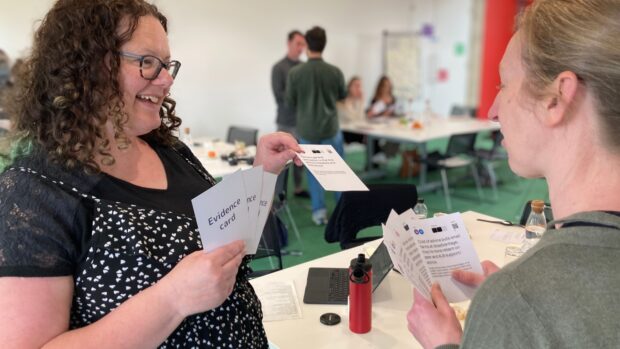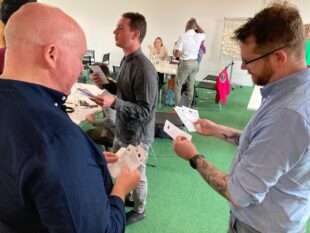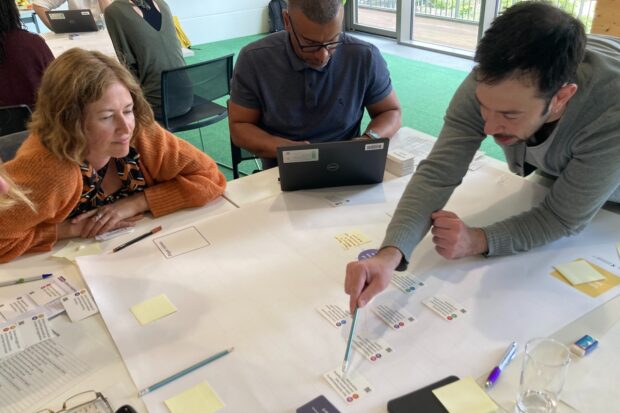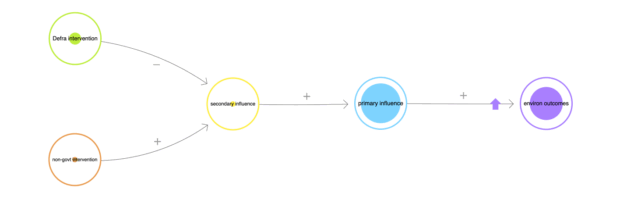
Inspired by the award-winning work of designers in the Ministry of Justice, our Policy Design Lab team in the Department for Environment, Food & Rural Affairs were keen to use system mapping to help policy colleagues make sense of their evidence base.
But systems maps can be visually overwhelming, often only making sense to those making them. The Foresight Obesity Systems Map is an often-quoted example of this. As a result, they can sometimes feel alienating and ultimately lose their value and impact.
We wanted to design a more participatory method of systems mapping that allowed a wider, more diverse group of colleagues to be involved in the sense making process.
Innovating how evidence is mapped
In our recent blog post, we described the challenges of evidence-based policy making that we’ve experienced on the Farming and Countryside Programme. In response, we ran a participatory workshop in June 2023 which combined systems mapping and serious games methods.

We worked with professional games designer Matteo Menapace to design a participatory ‘evidence mapping’ workshop, that allowed 36 colleagues with little or no prior knowledge of systems mapping to explore the 150 individual insights and build their own evidence maps. An important part of the workshop was printing off our insights as individual ‘nuggets’ or ‘evidence cards’. In the first part of the workshop, we used simple card swapping activities to socialise the evidence base and get colleagues familiar with the breath of insights.
One of our participants reflected on how this tactile approach allowed for a more engaging, collaborative experience of evidence review, for an activity which is often done in isolation in front of a computer:
“The fact that it was done with physical cards, physical activities, with us talking not looking at a screen much at all really, was very helpful. And it helped to maintain engagement levels.”
“The group exercise the way we did it, everyone going in turn, that mitigated any group issues that you always have were some people talk more than others. That was quite an innovative, creative way of doing a group exercise.”

By the end of the day, colleagues had identified both the vicious and virtuous cycles that connect the individual insights:
“It made it so easy to bring together so many diverse strands of thought that have emerged in the programme over time. As an analyst that was really useful because it really helped highlight the fact we’ve learnt an enormous amount and now the key thing is for us to home in on this question of our priorities, and what the scale of impact of all the different solutions that were being discussed around the tables might be.”
Visualising system stories
After the workshop we analysed the evidence maps and create an aggregated map identifying the underlying series of factors driving and blocking policy outcomes.
Knowing how overwhelming systems maps can be to read, we then broke down the aggregated map into 8 smaller (but still connected) maps or ‘system stories’. Each told an important story in the evidence base that significantly impacts the policy outcomes.
We made simple animated visuals of these system stories, allowing colleagues across the programme to appreciate how different insight ‘nuggets’ in the evidence impact each other.

The final framing was to introduce the notion of these system stories as ‘opportunity areas of work’ for the programme. This framing allowed us to identify and share new challenge questions (‘how might we...’) with the policy team to stimulate new thinking, ideas and hypotheses to test.
It also allowed us to identify existing work, beyond the scope of our programme’s work. That is already working to flip the system stories, addressing some of its delivery risks. This highlighted an important aspect of systems thinking, which is considering where to usefully draw the boundary to a system, which might involve challenging assumptions and silos.
Lessons for participatory mapping
For us there were five key learning areas from this work:
1. Using multidisciplinary working to actively bridge the ‘policy-delivery gap’
Inviting professionals from both the policy and delivery disciplines to contribute to our evidence discovery and take part in the evidence mapping workshop was an effective way to avoid overlooking insights and generate a wider variety of hypotheses and ideas to test. It was also an active way of demonstrating the value of a multidisciplinary team upstream in the policy space.
2. Embracing visual and physical ways of learning
We heard feedback during the evidence discovery that the visual images we used to theme the evidence helped people navigate and review the volume of evidence quickly. Similarly, we heard that the physical, tactile quality of printed evidence cards and the card swapping activities helped people digest and explore the insights in a more meaningful way than online workshops. These things reminded us of the value of investing in face-to-face working at points in a project when collective understanding and buy-in are critical to moving work forward.
3. Supporting knowledge management
Our insights database will now be added to a new programme-wide insights library, being led by the User Research Community in Defra. Our project went further, showing the potential for an accessible, searchable insights library to form the basis of a whole range of creative, innovative policy making workshops that invite diverse groups of people to review evidence, make meaning and imagine new policy ideas to test.
4. Framing the analysis
In our final playback we framed the system stories we’d identified as ‘opportunity areas of work’. However, on reflection, we’re learning that policy colleagues can often be more compelled to action by ‘risks’ and ‘mitigations’. This is an interesting and important learning for us about policymaker motivations, and how to inspire action from research and insights.
5. A note on language
We deliberately chose not to use the language of ‘system mapping’ which can sometimes feel overly technical or alienating for those coming new to the method. Instead, we stuck with plain English, describing the logical next step of ‘mapping’ the evidence after our earlier evidence discovery workshop.
Share your experience
Those were our key takeaways from this work, but we’re also curious to know what your reflections are on this participatory approach to systems mapping
- Could these ways of working be useful or relevant to your work?
- Maybe you’ve already tried something similar?
Let us know your thoughts below or email us: policydesignlab@defra.gov.uk
Join our community
We use this blog to talk about the work of the multidisciplinary policy design community. We share stories about our work, the thinking behind it and what policymaking might look like in the future. If you would like to read more, then please subscribe to this blog. If you work for the UK's government, then you can you join the policy design community. If you don't work for the UK government, then connect with us on social media at Design and Policy Network and subscribe here to be notified about our monthly speaker events to hear from influential design thought leaders and practitioners.
1 comment
Comment by Becky Miller posted on
Bonus content - here's the write up from our TransformGov Talk in June: https://medium.com/@transformgovtalks/seventh-event-write-up-c665f03488c7